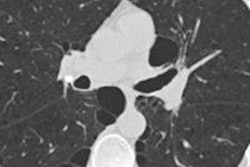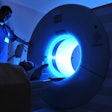
For lung nodules detected on CT, certain types can pose a higher risk of cancer for women than men, according to a study to be presented at the upcoming RSNA 2015 meeting in Chicago. The results indicate that radiologists may want to consider gender when interpreting CT lung screening scans.
In their study, researchers from Beth Israel Deaconess Medical Center in Boston, along with colleagues from several other institutions, analyzed CT images of more than 26,000 patients who participated in the landmark National Lung Screening Trial (NLST), which screened more than 58,000 long-term smokers with low-dose CT.
The results showed that lung cancer rates are influenced by both lung nodule consistency and the patient's gender. Specifically, women have a greater risk of lung cancer than men if they have nonsolid/ground-glass or part-solid nodules, while there was no statistically significant difference in risk for solid nodules.
"Women were 1.5 times more likely than men to have a ground-glass nodule detected by CT screening, and women with ground-glass nodules had a substantially higher relative risk of developing lung cancer than men," lead author Dr. Phillip Boiselle wrote in an email to AuntMinnie.com.
Boiselle is director of thoracic imaging at Beth Israel Deaconess and an assistant professor of radiology at Harvard Medical School. Study co-authors include Fenghai Duan, PhD; Stavroula Chrysanthopoulou, PhD; Sarah DeMello; Dr. Denise Aberle; and Dr. Caroline Chiles.
Gender differences unknown
The study represents a rare look at gender differences in lung cancer screening, Boiselle said.
"We know there are differences in cancer risk among different lung nodule consistencies, but we were unaware of any published reports that looked at the differences in lung cancer risk for nodule subtypes between women and men," he said in a statement.
To look for those gender differences, the study team examined images from NLST of all participants with nodules 4 mm to 30 mm in diameter that were detected at low-dose CT screening in NLST. They then divided the nodules by gender to look at the screening results.
For each nodule consistency type -- solid solitary pulmonary (SPN), nonsolid/ground glass (GGO), or part solid (PS) -- the investigators calculated sensitivity, specificity, and positive and negative predictive values for lung cancer for both men and women. Then, for each nodule consistency, they calculated the relative risk of lung cancer as the ratio of probability of lung cancer considering a reported nodule consistency.
Among 26,455 participants in the CT arm of the study, about 37% (n = 9,994) had a positive scan at one or more points during the screening trial. In all, 81% (n = 8,062) of those with a positive result had a solid nodule and 19% (n = 1,932) had a nonsolid/ground glass nodule.
Women face greater risk
For nonsolid/ground-glass nodules, the relative risk (RR) of lung cancer was significantly higher for women (RR = 2.68) than men (RR = 1.68), and the researchers found similar results for part-solid nodules (RR = 3.19 men, 4.45 women). Solid nodules, however, did not show a significant difference in risk between the genders.
Part-solid nodules had the highest positive predictive value for both sexes (15.3% for women, 12.3% for men). Solid nodules had the lowest positive predictive value for women (7.9%) and nonsolid/GGO nodules had the lowest positive predictive value for men (6.6%), Boiselle and colleague reported.
| Relative risk of lung cancer in men vs. women by nodule type | |||||
| Nodule consistency type | Relative risk for men | Relative risk for women | p-value (men and women) | ||
| Solid | 3.77 | 4.48 | 0.1970 | ||
| Nonsolid/GGO | 1.68 | 2.68 | 0.0026 | ||
| Part solid | 3.19 | 4.45 | 0.0556 | ||
Nonsolid nodules carry higher risks in women
"This study of over 26,000 participants in the CT arm of the NLST, including more than 40% women, provided a rare opportunity to study differences between the sexes with regard to lung nodule consistency and relative risk of lung cancer," Boiselle concluded. "These findings may have future implications for developing a more personalized, sex-specific approach to the optimal management of screen-detected ground-glass nodules."
When interpreting findings from CT lung cancer screening, radiologists should be aware of differences between the sexes in terms of the risk of lung cancer, according to the researchers.
"By looking at the rate at which lung cancers grow on serial CT scans, we can develop a better understanding of how often to obtain follow-up CT scans in men and women," Boiselle said in a statement.
While more study is needed, the results suggest that women may need more frequent follow-up than men. The group plans to continue studying the NLST data to get a better understanding of the significance of these cancers, particularly with regard to mortality.
The study will be presented on Sunday, November 29, at 10:55 a.m. in Room S404CD at the upcoming RSNA meeting in Chicago.



















